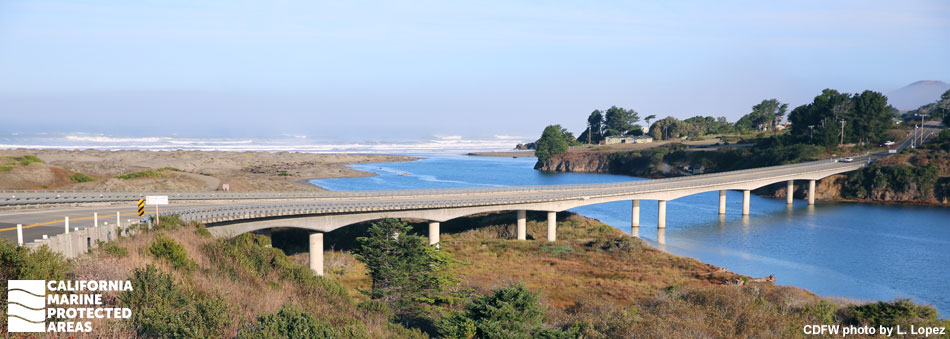
Overview
Ten Mile State Marine Reserve (SMR), Ten Mile Beach State Marine Conservation Area (SMCA), and Ten Mile Estuary SMCA are located less than 10 miles north of the town of Fort Bragg on the rugged Mendocino coast.
The northernmost of the three MPAs, Ten Mile SMR stretches along three miles of coastline and extends from shore out three nautical miles. Covering almost 12 square miles of open water habitat and reaching depths of over 300 feet, the SMR protects rocky shorelines, offshore islets, deep rocky reef, sandy seafloor, and surfgrass and kelp bed habitats.
Ten Mile Beach SMCA stretches along less than one mile of coastline, extending from shore out three nautical miles. Covering about three and a half square miles of open water habitat and reaching depths of over 280 feet, Ten Mile Beach SMCA protects sandy beaches, rocky shorelines, and sandy seafloor habitats.
The seafloor habitat of the two coastal MPAs is a mix of hard and soft sands, gravels, and rocks. The sheltered portions of rocky shoreline and marine terraces provide haul out areas for seals and sea lions, and critical nesting and roosting sites for seabirds. The rocky reef habitat is refuge for urchins, anemones, sea cucumbers, sponges, sea stars, and rockfish, and the sandy seafloor is inhabited by sand crabs, sea whips, sand dollars, and flatfish, among many other species.
Predominantly composed of coastal marsh habitat, Ten Mile Estuary SMCA is one of the least developed estuaries along the northern California coast. The extensive, intact estuarine, wetland, and riparian habitat of Ten Mile Estuary SMCA supports a range of species. The SMCA encompasses spawning and nursery grounds for rockfish and coho salmon, roosting and foraging areas for shorebirds and seabirds, and a transportation corridor for river otters.
Several coastal access points to the three MPAs facilitate recreation, research, long-term monitoring, and enforcement activities.
Regulations
Ten Mile SMR
It is unlawful to injure, damage, take, or possess any living, geological, or cultural marine resource.
California Code of Regulations Title 14, Section 632(b)(19)(opens in new tab)
Ten Mile Beach SMCA
It is unlawful to injure, damage, take, or possess any living, geological, or cultural marine resource, EXCEPT:
Recreational take of Dungeness crab by trap, hoop net or hand is allowed. Commercial take of Dungeness crab by trap is allowed. Includes take exemptions for some tribes.
California Code of Regulations Title 14, Section 632(b)(20)(opens in new tab)
Ten Mile Estuary SMCA
It is unlawful to injure, damage, take, or possess any living, geological, or cultural marine resource, EXCEPT:
Take of waterfowl in accordance with general waterfowl hunting regulations is allowed. Includes take exemptions for some tribes.
California Code of Regulations Title 14, Section 632(b)(21)(opens in new tab)
Quick Facts
Ten Mile SMR
MPA size: 11.95 square miles
Shoreline span: 3.2 miles
Depth range: 0 to 343 feet
Habitat composition*:
- Rock: 3.22 square miles
- Sand/mud: 10.38 square miles
Ten Mile Beach SMCA
MPA size: 3.54 square miles
Shoreline span: 0.9 miles
Depth range: 0 to 288 feet
Habitat composition*:
- Rock: 0.04 square miles
- Sand/mud: 3.51 square miles
Ten Mile Estuary SMCA
MPA size: 0.18 square miles
Shoreline span: 0.1 miles
Habitat composition*:
- Coastal marsh: 0.78 square miles
- Estuary: 0.08 square miles
*Habitat calculations are based on three-dimensional area and may exceed the total MPA area listed above.